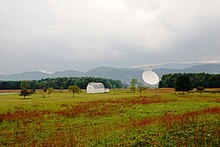Green Bank Observatory
 Green Bank Telescope at NRAO Green Bank, September 2009 | |
| Alternative names | National Radio Astronomy Observatory, Green Bank |
|---|---|
| Named after | Green Bank |
| Organization | Associated Universities, Inc. |
| Location | Green Bank, United States National Radio Quiet Zone, Pocahontas County, US |
| Coordinates | 38°26′16″N 79°50′10″W / 38.437896°N 79.836169°WCoordinates: 38°26′16″N 79°50′10″W / 38.437896°N 79.836169°W |
| Altitude | 2,684 feet (818 m) |
| Observing time | 365 nights per year |
| Established | November 12, 1956 |
| Website | greenbankobservatory |
| Telescopes | 300 foot Radio Telescope Ewen–Purcell Horn Antenna Green Bank Jansky Antenna Green Bank Interferometer Green Bank Telescope Reber Radio Telescope |
 Location of Green Bank Observatory | |
The Green Bank Observatory (previously National Radio Astronomy Observatory, Green Bank) is an astronomical observatory located in the National Radio Quiet Zone in Green Bank, West Virginia, U.S. It is the operator of the Robert C. Byrd Green Bank Telescope, the world's largest fully steerable radio telescope.[1]
The observatory was established as the National Science Foundation's (NSF) National Radio Astronomy Observatory (NRAO) in 1956, and made its first observations in 1958.[2][3][4][5] It served as the NRAO's headquarters until 1966, after which the facility was known as the National Radio Astronomy Observatory, Green Bank.[3][6]
In October 2016, the observatory became an independent institution, following a 2012 recommendation that the NSF fully divest itself from the facility by October 1, 2016.[4][7][8][9]
Green Bank Observatory subsequently retained partial NSF funding, established private contracts, and formed a partnership with West Virginia University.[10][4] It is operated by the nonprofit Associated Universities, Inc., under a cooperative agreement with the National Science Foundation.[10]
Active telescopes[]
- Green Bank Telescope[1]
- 140 Foot (43m) Telescope[11][12]
- 20 Meter Telescope[11]
- 40 Foot Telescope[11]
Historic and other telescopes[]

day of collapse

- 300 Foot Radio Telescope – suddenly collapsed in November 1988, from the loss of a gusset plate[13][14]
- Green Bank Interferometer
- Reber Radio Telescope – designated a National Historic Landmark in 1989
- Howard E. Tatel Radio Telescope — utilized in Project Ozma in 1960, the first search for extraterrestrial intelligence (SETI) with a radio telescope[11][5][15]
- 45 Foot Telescope[11]
See also[]
References[]
- ^ Jump up to: a b Robert C. Byrd Green Bank Telescope at Emporis. Retrieved December 30, 2019.
- ^ The Editors of Encyclopaedia Britannica (February 18, 2010). "National Radio Astronomy Observatory". Encyclopædia Britannica. Encyclopædia Britannica, inc. Retrieved December 30, 2019.
- ^ Jump up to: a b "National Radio Astronomy Observatory Archives: NRAO Timeline". National Radio Astronomy Observatory. Retrieved December 30, 2019.
- ^ Jump up to: a b c Scoles, Sarah (October 7, 2016). "What Happens When a Space Observatory Goes Rogue". Wired. Condé Nast. ISSN 1078-3148. OCLC 24479723. Retrieved January 1, 2020.
- ^ Jump up to: a b "Timeline for Green Bank Observatory". Green Bank Observatory. Retrieved January 1, 2020.
- ^ Library of Congress. "National Radio Astronomy Observatory (U.S.)". LC Name Authority File (LCNAF). Retrieved December 30, 2019.
Earlier Established Forms – United States. National Radio Astronomy Observatory, Green Bank, W. Va.
- ^ Temming, Maria (October 1, 2016). "Green Bank Observatory Goes Independent". SkyAndTelescope.com. Retrieved July 20, 2017.
- ^ Steelhammer, Rick (February 26, 2016). "Funding for Green Bank Observatory falls". The Charleston Gazette-Mail. Retrieved December 30, 2019.
- ^ "Green Bank Observatory: The Making of an American Astronomy Icon". AstronomyNow.com. Retrieved July 20, 2017.
- ^ Jump up to: a b Stump, Jake (July 30, 2019). "Green Bank Observatory, site for breakthrough WVU research and teaching, to remain open" (Press release). Morgantown, WV: West Virginia University. WVU Research Communications. Retrieved December 30, 2019.
- ^ Jump up to: a b c d e "Telescopes: The Telescopes of the GBO". Green Bank Observatory. Retrieved January 1, 2020.
- ^ "Telescopes: 140 Foot (43m) Telescope". Green Bank Observatory. Retrieved January 1, 2020.
- ^ Green Bank Telescope ( old) at Emporis. Retrieved December 30, 2019.
- ^ "300-foot Telescope". National Radio Astronomy Observatory. Retrieved December 15, 2020.
- ^ The Editors of Encyclopaedia Britannica (February 13, 2008). "Project Ozma". Encyclopædia Britannica. Encyclopædia Britannica, inc. Retrieved January 1, 2020.
External links[]
| Wikimedia Commons has media related to Green Bank Observatory. |
- Official website

- 458928697 Green Bank Observatory on OpenStreetMap
- Green Bank Observatory (2019). Green Bank Observatory 2020 (PDF). Green Bank, West Virginia.
- Green Bank Observatory bird sightings on eBird

- Astronomical observatories in West Virginia
- Radio observatories
- Astronomy institutes and departments
- Organizations based in West Virginia
- Research institutes in the United States
- Research institutes established in 1956
- Scientific organizations established in 1956
- 1956 establishments in West Virginia
- National Science Foundation

